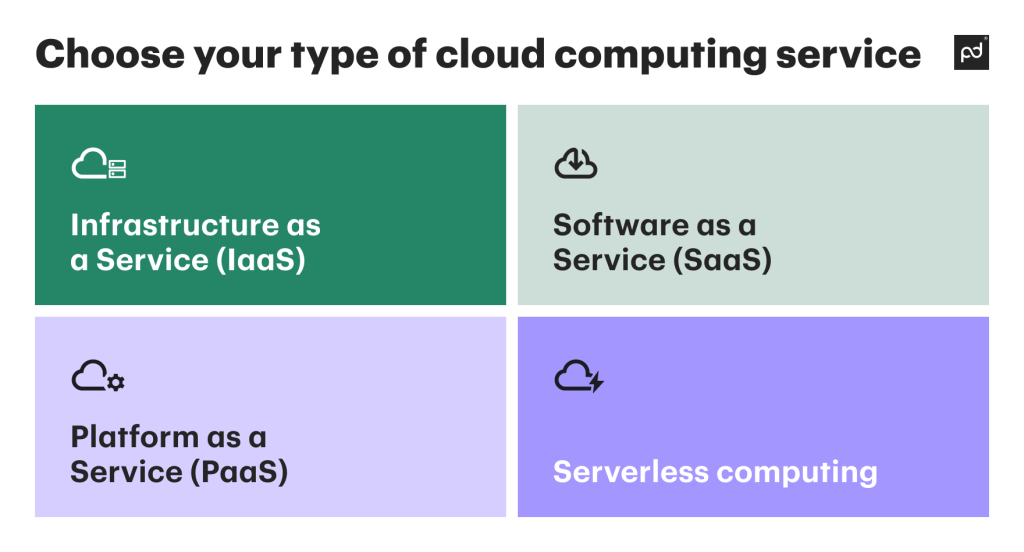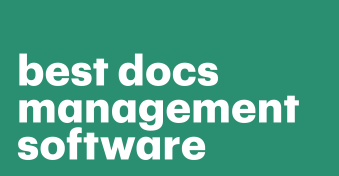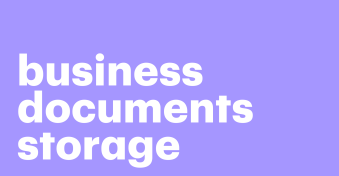About 85% of businesses1 are expected to adopt a cloud-first strategy by 2025, becoming more agile and flexible.
With cloud technology, businesses can securely deliver SaaS services and embrace new platforms.
At the core are cloud agreements business owners sign with one or multiple cloud providers.
This legally binding contract outlines the terms and conditions between a cloud service provider and a business that needs the cloud to store customer data, run applications, or access software online.
In this article, we’ll discuss the essential components of a cloud agreement and the tools and templates you can use to create an enforceable one and have it signed by all involved parties.

Different cloud computing paradigms enable businesses to deliver modern applications that store massive volumes of data beyond the confines of on-premise hardware.
Whether you’re looking for a disaster recovery solution or rolling out a SaaS CRM, there’s a specific type of cloud infrastructure to empower your business goals.
Let’s look at the four types of cloud services.
Infrastructure as a Service (IaaS)
When you seek on-demand access to computing power, storage, and virtualization resources directly from the cloud — consider the IaaS form of cloud computing.
IaaS tends to be more expensive than other types of cloud services since it offers the highest flexibility.
Such services as Amazon EC2, Microsoft Azure Virtual Machines, or Google Compute Engine can allow scaling up the infrastructure instantly.
For e-commerce businesses, it provides crucial stability for smooth business operations during peak traffic.
It will also fit in with your business continuity plan or disaster recovery strategy.
Rather than investing in servers across various locations, you can deploy your continuity/recovery solution to the cloud provider’s already spread-out infrastructure.
Software as a Service (SaaS)
When you need access to ready-to-use software applications without the hassle of installing and maintaining them, a SaaS cloud is what you need.
A third-party provider hosts all the necessary apps that your business or your clients can access online with just a few clicks.
You’re undoubtedly familiar with such SaaS services as the Salesforce CRM platform to keep customer-related information in one place, Microsoft 365 with tools like Word and Excel, or Google Workspace, which helps teams collaborate smoothly.
Small businesses massively lean on SaaS products to keep day-to-day operations running smoothly.
Larger organizations, including enterprises, may also sign cloud agreements to manage finances, handle customer relationships, or simplify repetitive email marketing tasks.
Platform as a Service (PaaS)
You can compare this type of cloud computing service to a behind-the-scenes powerhouse that a provider offers developers to help manage hardware and software.
This means developers can redirect their time and effort to what they do best: creating modern applications.
Google App Engine is an example of PaaS that offers developers a fully managed environment where they can build and deploy projects.
Such a PaaS platform as Heroku eases rolling out applications, and Microsoft Azure App Service simplifies building, deploying, and scaling web apps.
When you sign an agreement with a cloud provider, you de facto invite a partner to help you boost the productivity of the development departments and foster innovation and creativity.
Serverless computing
Serverless computing automates server and infrastructure management tasks (unlike PaaS which reduces and simplifies managing hardware).
Using the serverless approach, developers can build and run applications without managing a server.
This is particularly effective for scaling applications dynamically.
You pay only for the computing resources adjusted to your developers’ needs.
Some serverless services are AWS Lambda, which executes code in response to events, Azure Functions, which facilitate event-driven scenarios, or Google Cloud Functions, which start code execution based on specific events.
Define parties and responsibilities in a cloud service agreement
Signing an enforceable cloud service agreement finalizes clearly defined roles and responsibilities — essential to successfully handling cloud services and cloud-based business processes.
There are three key parties entering the agreement: a cloud service provider, a client, and a third-party vendor.
Cloud service providers (CSP)
The CSP is the backbone of cloud services, responsible for maintaining the physical infrastructure, keeping data secure, and providing reliable access to cloud services.
Typical CSPs are such giants as Amazon, Microsoft, and Google.
CSPs make sure the system is up-to-date and complies with all relevant regulations (such as GDPR).
Client
The client (namely you) engages with the provider to use cloud services. As a client, you’re responsible for data privacy when sending it to and from the cloud.
The business operations you run should comply with legal and regulatory requirements relevant to your industry and data.
Besides, you’re responsible for managing user access and identity verification processes to control who can access the cloud services.
Third-party vendors
A vendor’s role in a cloud agreement is to support a provider by offering additional services.
For example, specialized software that integrates with a cloud platform or consulting services.
Third-party vendors are responsible for meeting the agreed-upon standards and integrating with a provider’s infrastructure. They also oversee data security and compliance.
Consider these key metrics before signing a cloud agreement
Now that you understand which party handles specific responsibilities in the agreement, it’s important to check what to expect from your cloud service provider.
Think of the following key cloud service metrics as the dashboard to gauge the service, giving you real-time insights into performance and efficiency:
- Volume (this is the amount of data a service can handle at once)
- Precision and accuracy (a server should operate error-free and be reliable)
- Speed (the higher this metric, the faster you’ll get your tasks processed on a server)
- Response time (a server worthy of investment responds quickly to queries)
- Efficiency (a server should use such resources as CPU, storage, or RAM in the optimal way to achieve expected results)
Keep an eye on these metrics while collaborating with other involved parties on a cloud agreement.
You don’t want any blind spots in this area after placing your physical or electronic signature on the document.
Components of cloud agreements
Cloud computing agreements are packed with critical components that define the performance, security, and legal boundaries of the services you’re looking to utilize.
Without getting bogged down in legal jargon, here’s a straightforward breakdown of the key aspects to understand before signing a cloud agreement.
Service level agreements (SLAs)
A service level agreement is a promise from a cloud service provider, specifying the expected performance and availability of the levels of the service.
For example, SLAs may guarantee 99.9% uptime to ensure minimal interruptions of business operations.
Moreover, this part of the cloud agreement typically establishes how quickly you can expect the services to be restored in case of an issue.
Data protection
The security provisions are crucial in a cloud agreement as they outline how a cloud provider protects data in compliance with privacy laws and regulations.
This includes the methods of data encryption and security protocols used to safeguard personal data.
Depending on the geographical location of your business and/or your clients, all gathered and stored data must adhere to data residency requirements such as eIDAS for the European Union or HIPAA for healthcare data in the US.
The agreement should lay out the measures and procedures to be followed in the event of potential data breaches.
Terms and conditions
For both your business and the cloud provider, the terms and conditions part of the agreement details all legal obligations and protections.
These include payment terms and payment schedules, data ownership (and what happens to the data if you terminate the service), each party’s liabilities in case of service failure, and related indemnification details.
Consider the three sections mentioned above as non-negotiable when reviewing a cloud agreement.
Make sure they are clearly defined and set a solid foundation for a smooth collaboration.
Best practices to negotiate and maintain cloud agreements
Creating a legally binding cloud agreement involves more than choosing a type of service you need and a reliable provider.
You need the provider to stay on the same page with your business needs and effectively manage risks.
Let’s explore how to make negotiations quick — and successful!
Understand your goals
You need a clear understanding of how cloud services will improve your business operations, the necessary cloud technical requirements and functionality, and how these aspects intersect with your budget.
Communicate that efficiently to a cloud provider to receive value-adding services.
Beware of hidden costs
Additional costs like data transfers, security measures, and backups can increase the final price.
Factor these into your budget plan to create realistic business scenarios when negotiating vendor contracts — and evade unexpected costs down the line.
Focus on a risk mitigation strategy
Choose a cloud provider whose security policies and compliance standards match your business requirements.
In addition, carefully review the agreement’s provisions on handling large volumes of data and the service termination period.
Make sure you have ample time to securely transfer all the data in the event of terminating the agreement.
Consider your geographical location
When running a business across different jurisdictions, you might stumble upon varied contractual practices and local legal systems.
Negotiate potential bottlenecks carefully to evade these and similar risks.
Communicate with stakeholders
Keep all relevant parties in the loop about the intended cloud expenses and the implications.
You will prevent unsanctioned cloud spending, streamline budgeting, and allocate enough resources — all while strengthening your negotiating position.
Create enforceable cloud agreements with PandaDoc
You can choose from a variety of cloud services and functionalities; however, you’ll need simple tools to draft, collaborate on, and sign enforceable business documents.
PandaDoc offers templates that cover the essential elements of cloud agreements.
You can collaborate on documents with stakeholders and cloud providers via real-time commenting and edits to refine agreements.
Store and manage your cloud agreements effectively with document management software — don’t allow contract complexities to hold you back.
And go further by automating routine document-related processes to speed up negotiations and improve document workflow.
Sign up for a free trial to experience firsthand how to make your cloud journey clear and manageable.
Disclaimer
PandaDoc is not a law firm, or a substitute for an attorney or law firm. This page is not intended to and does not provide legal advice. Should you have legal questions on the validity of e-signatures or digital signatures and the enforceability thereof, please consult with an attorney or law firm. Use of PandaDoc services are governed by our Terms of Use and Privacy Policy.


